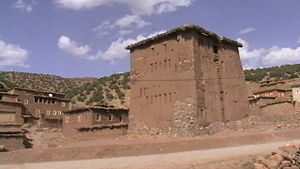Ibakliwin
| Ibakliwin | ||||
|---|---|---|---|---|
|
||||
| Basic data | ||||
| State : |
|
|||
| Region : | Béni Mellal-Khénifra | |||
| Province : | Azilal | |||
| Coordinates | 31 ° 40 ′ N , 6 ° 24 ′ W | |||
| Residents : | 300 | |||
| Height : | 1820 m | |||
Ibakliwin (also Ibaqalliwn or Ibaqlioun ) is a small mountain village inhabited by Berbers with around 300 inhabitants and around 50 houses in the Aït Bougoumez valley on the north side of the High Atlas in the Azilal province ( Béni Mellal-Khénifra region ), Morocco . The village is part of the rural commune ( commune rurale ) of Tabant .
location
Ibakliwin is located on the southern edge of the Aït Bouguemez Valley, about 30 kilometers long and about 1800 meters high. Another 30 villages are grouped along the valley and mostly on stony ground - including Tabant, about 2 km to the west, and Timit, about 5 km to the west . The place can be easily reached by minibus or car from the provincial capital of Azilal, which is about 80 km away (driving distance), via an asphalt, but winding road.
landscape
The valley is bordered to the south by the snow-covered peaks of the Jbel-M'Goun massif until late spring (on the north side sometimes until June) , whose meltwater ensures a permanent and year-round water supply for people, animals and cultivated areas. In this way, two harvests are sometimes even possible, which has earned the valley the nickname “Happy Valley”.
economy
For centuries the economy of the remote but fertile valley was geared towards self-sufficiency and self-sufficiency; Markets were simply too far away. A system of strict controls ( agdal ), which is strictly based on availability, individual needs and the common use of natural resources (water, soil, wood, etc.), enables the inhabitants of the high valley to survive successfully and sustainably even today.
Attractions
- Ibakliwin has retained much of its original character: Some of the clay buildings are still inhabited and sometimes a part of domestic life (preparing food, cooking, baking bread, braiding and weaving, etc.) still takes place on the doorstep. In most of the other villages in the valley, many old houses have already been replaced by new buildings with walls made of hollow bricks, ceilings made of concrete and satellite dishes on the roofs, which has a direct impact on the coexistence of people - mutual isolation is increasing.
- On the outskirts is one with erbauter on square plan many vents, also called loopholes could be used-provided tower loose military and storage tower ( Agadir ), the interior of the residents in attacks offered warring neighboring villages or wandering nomads protection. In addition, valuables, i. H. Agricultural implements made of metal, weapons etc. as well as food are stored safely.
- On a nearby rock there are regularly arranged indentations, which are interpreted as the footprints of dinosaurs .
Trekking
Guided hiking and trekking tours are offered by local operators; The M'Goun massif (4071 m) and other mountains can also be climbed almost all year round .
See also
- Ourika valley
- Berber architecture
- Igherm n'Ougdal
- Agadir Tasguent
- Amtoudi
- Imchiguegueln
- Agadir Imi'm Korn
- Agadir Guimst


